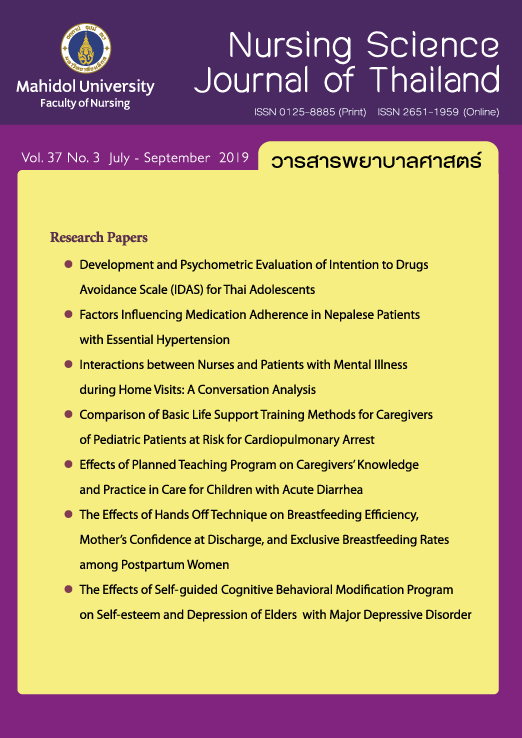Comparison of Basic Life Support Training Methods for Caregivers of Pediatric Patients at Risk for Cardiopulmonary Arrest
Main Article Content
Abstract
Purpose: The purpose of this experimental study was to compare the results of two training methods of Basic Life Support (video with nurse instruction and nurse instruction only) on knowledge and performance of caregivers of pediatric patients at risk for cardiopulmonary arrest.
Design: Experimental research.
Methods: The 98 participants were primary caregivers of pediatric patients at risk for cardiopulmonary arrest who were admitted at Siriraj hospital. Data were collected by a demographic information interview form, knowledge of basic life support questionnaire, and checklist form for assessing performance in pediatric basic life support. Statistical analysis included descriptive statistics, Mann – Whitney U test, Chi - square and, Fisher’s exact test.
Main findings: The differences of knowledge and performance of basic life support between the group taught by using video with nurse instruction and the other one using nurse instruction spent less time to educate and teach the caregivers, compared to thos in their counterpart group (Z = -7.43, p < .05).
Conclusion and recommendations: Either using video with nurse instruction or nurse instruction only as a teaching method yields similar effectiveness on caregivers’ knowledge and practice skills of basic life support. Thus, the use of video with nurse instruction should be encouraged in nursing practice as it consumes less time from nurses. Moreover, the video should be given to caregivers for review at home so that their skills would be sustainable.
Article Details
Copyright Notice: Nursing Science Journal of Thailand has exclusive rights to publish and distribute the manuscript and all contents therein. Without the journal’s permission, the dissemination of the manuscript in another journal or online, and the reproduction of the manuscript for non-educational purpose are prohibited.

Disclaimer: The opinion expressed and figures provided in this journal, NSJT, are the sole responsibility of the authors. The editorial board bears no responsibility in this regard.
References
2. Kitamura T, Iwami T, Kawamura T, Nagao K, Tanaka H, Nadkarni VM, et al. Conventional and chest-compression-only cardiopulmonary resuscitation by bystanders for children who have out-of-hospital cardiac arrests: a prospective, nationwide, population-based cohort study. Lancet. 2010;375(9723):1347-54.
3. Waalewijn RA, Tijssen JG, Koster RW. Bystander initiated actions in out-of-hospital cardiopulmonary resuscitation: results from the Amsterdam Resuscitation Study (ARRESUST). Resuscitation. 2001;50(3):273-9.
4. Pierick TA, Van Waning N, Patel SS, Atkins DL. Self-instructional CPR training for parents of high risk infants. Resuscitation. 2012;83(9):1140-4.
5. Higgins SS, Hardy CE, Higashino SM. Should parents of children with congenital heart disease and life-threatening dysrhythmias be taught cardiopulmonary resuscitation? Pediatrics. 1989;84(6):1102-4.
6. Ubol L, Prasopkittikun T, Srichantaranit A, Vijarnsorn C. Basic life support training via Video CD for caregivers of pediatric patients at risk for cardiopulmonary arrest. Journal of Nursing Science. 2016;34(3):66-78. (in Thai).
7. Flint LS Jr, Billi JE, Kelly K, Mandel L, Newell L, Stapleton ER. Education in adult basic life support training programs. Ann Emerg Med. 1993;22(2 Pt 2):468-74.
8. Kaye W, Rallis SF, Mancini ME, Linhares KC, Angell ML, Donovan DS, et al. The problem of poor retention of cardiopulmonary resuscitation skills may lie with the instructor, not the learner or the curriculum. Resuscitation. 1991;21(1):67-87.
9. Chung C, Siu AY, Po LL, Lam C, Wong PC. Comparing the effectiveness of video self-instruction versus traditional classroom instruction targeted at cardiopulmonary resuscitation skills for laypersons: a prospective randomised controlled trial. Hong Kong Med J.2010;16(3):165-70.
10. Roppolo LP, Pepe PE, Campbell L, Ohman K, Kulkarni H, Miller R, et al. Prospective, randomized trial of the effectiveness and retention of 30-min layperson training for cardiopulmonary resuscitation and automated external defibrillator: The American Airlines Study. Resuscitation. 2007;74(2):276-85.
11. Batcheller AM, Brennan RT, Braslow A, Urrutia A, Kaye W. Cardiopulmonary resuscitation performance of subjects over forty is better following half-hour video self-instruction compared to traditional four-hour classroom training. Resuscitation. 2000;43(2):101-10.
12. Todd KH, Braslow A, Brennan RT, Lowery DW, Cox RJ, Lipscomb LE, et al. Randomized, controlled trial of video self-instruction versus traditional CPR training. Ann Emerg Med. 1999;34(6):730-7.
13. Braslow A, Brennan RT, Newman MM, Bircher NG, Batcheller AM, Kaye W. CPR training without an instructor: development and evaluation of a video self-instructional system for effective performance of cardiopulmonary resuscitation. Resuscitation. 1997;34(3):207-20.
14. Einspruch EL, Lynch B, Aufderheide TP, Nichol G, Becker L. Retention of CPR skills learned in a traditional AHA hartsaver course versus 30-min video self-training: a controlled randomized study. Resuscitation. 2007;74(3):476-86.
15. Lynch B, Einspruch EL, Nichol G, Becker LB, Aufderheide TP, Idris A. Effectiveness of a 30-min CPR self-instruction program for lay responders: a controlled randomized study. Resuscitation. 2005;67(1):31-43.
16. Dracup K, Moser DK, Doering LV, Guzy PM. Comparison of cardiopulmonary resuscitation training methods for parents of infants at high risk for cardiopulmonary arrest. Ann Emerg Med.1998;32(2):170-7.
17. Sakcharoen P. Adult learning theory and self-directed learning concept: learning process for promoting lifelong learning. Journal of The Royal Thai Army Nurses. 2015;16(1):8-13.
18. Atkins DL, Berger S, Duff JP, Gonzales JC, Hunt EA, Joyner BL, et al. Part 11: Pediatric basic life support and cardiopulmonary resuscitation quality: 2015 American Heart Association guidelines update for cardiopulmonary resuscitation and emergency cardiovascular care. Circulation. 2015;132(18 Suppl 2):S519-25.
19. Fleiss JL, Tytun A, Ury HK. A simple approximation for calculating sample sizes for comparing independent proportions. Biometrics. 1980;36(2):343-6.
20. Kouwenhoven WB, Jude JR, Knickerbocker GG. Closed-chest cardiac massage. JAMA. 1960;173:1064-7.
21. Srichantaranit A, Chungsomprasong P, Vijarnsorn C, Sukthongsa W, Udomponglukana N, Jaturachaidech C. Comparing the effects of teaching with VCD and teaching with flip chart on knowledge and anxiety of mothers in caring for children undergoing cardiac ctheterization. Journal of Nursing Science. 2014;32(2):41-51. (in Thai).
22. Brannon TS, White LA, Kilcrease JN, Richard LD, Spillers JG, Phelps CL. Use of instructional video to prepare parents for learning infant cardiopulmonary resuscitation. Proc (Bayl Univ Med Cent). 2009;22(2):133-7.
23. Mpotos N, Yde L, Calle P, Deschepper E, Valcke M, Peersman W, et al. Retraining basic life support skills using video, video feedback or both: a randomised controlled trial. Resuscitation. 2013;84(1):72-7.


